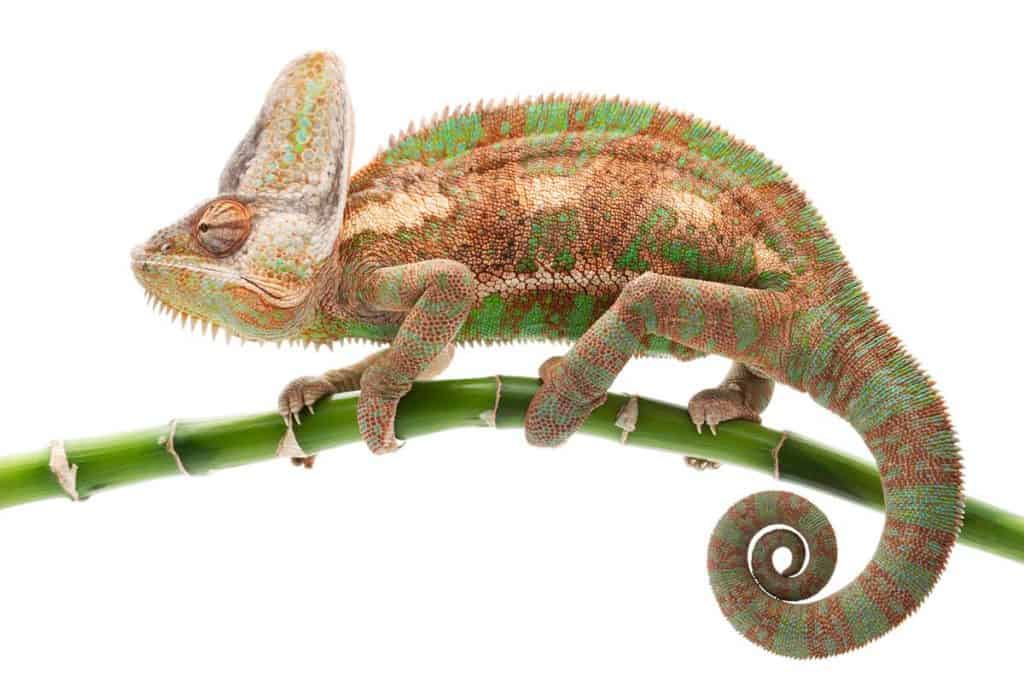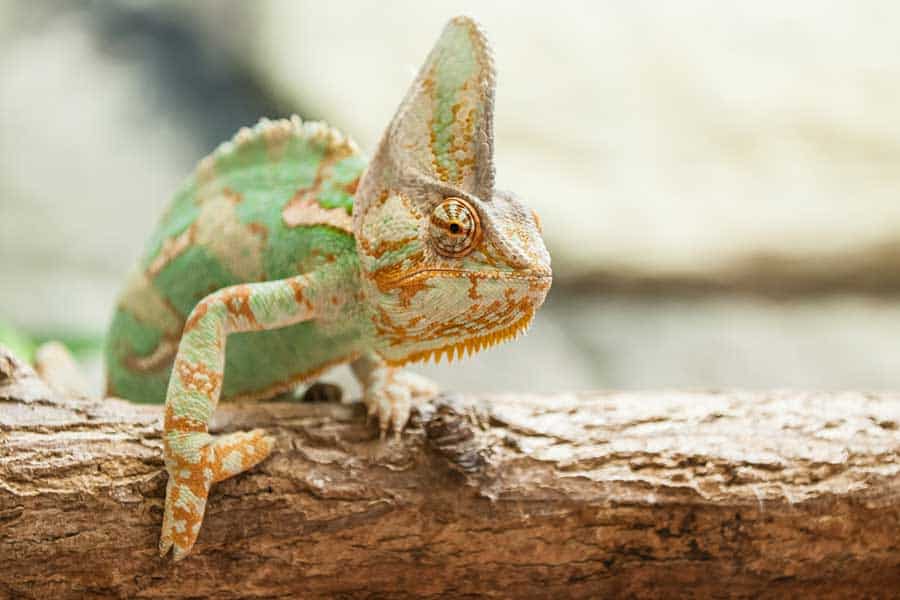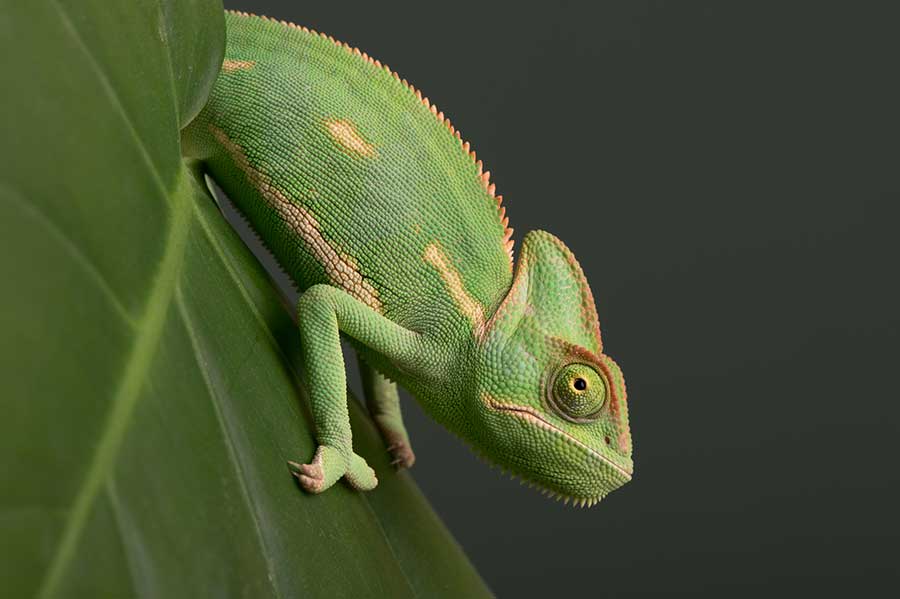I think chameleons are such fascinating creatures, and so gorgeous too! And of the myriad chameleon species, veiled chameleons are some of the coolest looking and have great temperaments.
However, veiled chameleon care is not as simple and straightforward as other popular lizard pets for beginners, and I wouldn’t recommend them to first-time reptile owners! Chameleons can be very unforgiving pets when their owners make mistakes in their care. I would say they fare much better under the care of more experienced reptile owners.
To make sure you’re up to the task, keep reading to learn more about how to take care of a veiled chameleon.
An Overview of the Veiled Chameleon
Veiled chameleons are very interesting to look at, which makes them an excellent display reptile to have. On average, they live for around six to eight years in captivity.
Males will tend to live longer than females, even if the best care is given to your female chameleon. This is mostly because females often lay eggs even without a male present, which puts a lot of repeated stress on their bodies over time.
Physical Attributes
Veiled chameleons are sexually dimorphic, which just means males and females differ slightly in size and physical appearance. Males grow to between 17 and 24 inches in length, while females rarely reach beyond 14 inches.
Veiled chameleons are easily recognizable by their large head casque. Their head casque is a bony-looking triangle that sticks up on the top of their heads like a sail or a crest. Interestingly, they use this casque to direct water droplets down to their mouths in the wild and in captivity!
Veiled chameleons are primarily green and have mottling on their skin of a variety of different colors. This mottling can be white, yellow, orange, or tan. Some morphs are bred to have extreme coloration and mottling in vibrant shades of blue and red!
Behavior
Although they are generally quite docile, veiled chameleons are also rather territorial by nature, so they do not play well with others. This means they will be aggressive to other reptiles of any kind and should be housed by themselves in their own enclosure.
When a veiled chameleon is feeling aggressive, they will expand their chests, stick out their legs, brighten their colors, and hiss. If they are preparing to attack, they will bob their head to poke or bite their victim whether it is another reptile or your fingers, so watch out for this behavior.
However, if a veiled chameleon is feeling submissive or subdued, they will sit very still and try to hide in the foliage. They will also make their coloration as dull as possible to look as least intimidating as possible.
Your Veiled Chameleon’s Enclosure
Chameleons need specific enclosures in order to thrive. You cannot simply convert your old bearded dragon enclosure into a veiled chameleon’s enclosure. Chameleons are arboreal, which means they live in trees and love to climb. Here’s what you need to know when it comes to setting up your chameleon’s enclosure.
Size
Veiled chameleons need plenty of height in their enclosures. They will spend very little time, if any, on the ground. This means you need to provide them with an enclosure that has more vertical space than horizontal space.
- Juvenile veiled chameleons need an enclosure that is roughly 30 inches high and 16 inches wide and deep.
- Adult veiled chameleons need an enclosure that is roughly four feet high and two feet wide and deep. Bigger is always better if you can manage it.
It is important to keep your chameleon in an appropriately-sized enclosure. Keeping a juvenile in an adult’s enclosure or vice versa will cause them a huge amount of stress and can shorten their lifespan considerably. Chameleons are uniquely prone to stress-related health problems, so an appropriate enclosure is crucial to their wellbeing.
Material
A veiled chameleon’s enclosure should not be made completely of glass because chameleons do not understand their own reflections. They tend to think their reflection is another chameleon and will become either extremely aggressive or subdued. This causes them stress and can shorten their lifespan.
An ideal enclosure should be made of plastic-coated mesh to promote airflow or at least have a screened or mesh top. Stagnant air will cause respiratory problems and interfere with humidity levels in the enclosure.
Overall, your chameleon’s habitat should provide suitable air flow and have plenty of height and space for your average-sized male or fully-grown female chameleon to move around in.
Substrate
Veiled Chameleons are completely arboreal, which means you do not need to have substrate at all! However, a proper substrate that retains moisture well can help promote the high humidity settings these particular lizards need to thrive. Plus, an attractive substrate can make the enclosure look better overall and more aesthetically pleasing to you and your chameleon.
If you do choose to have substrate in your chameleon’s enclosure, it is best to use substrate that does not have loose, indigestible particles like sand or wood chips, as they can cause digestive impaction.
Good substrates to use are coconut husk, reptile carpet, or organic soil with no fertilizers in it.
Shelter Features
Finally, you’ll need lots of “furniture” to create clutter and adequate shelter for your chameleon so they don’t feel exposed. Since they are very shy lizards that are prone to stress, having plenty of plant cover and shelter can make veiled chameleons feel more comfortable and safe in their enclosures. Below are some ideas you should consider.
Perches
It is vital for your chameleon to have many perches and/or branches to move around in their enclosure. Because they do not spend any time on the ground, they do not need hides on the floor of the enclosure.
You can use natural branches, wooden perches, or even PVC pipes in the enclosure. There should be a variety of secure perches at different levels throughout the enclosure. Some of the perches should be horizontal, while others should be at no more than a 45° angle. Variation is key here.
If you use natural wood or branches, make sure you sterilize them properly before introducing them to your veiled chameleon’s enclosure.
To do this, simply boil the branches in water to kill off any microorganisms such as fungi and mites. Once they have boiled for roughly half an hour, place them in the sun to dry. Alternatively, you can place them in the oven with the door open at a low temperature.
Foliage
There should be plenty of coverage in the enclosure in the form of foliage. You can use artificial foliage as it is cheap, easy to maintain, and you can reuse it and clean it easily without worrying about it dying.
You can also include live plants in the enclosure. Using live plants will help maintain humidity levels and give the enclosure a more natural feel. Make sure to carefully research which plants you use to ensure they are not toxic to veiled chameleons.
Check out our guide on the best plants to have in your chameleon’s enclosure!
Climate Control
Heating
One of the most important care requirements for veiled chameleons is proper temperature. Because they are ectothermic reptiles, chameleons rely on their environment to adjust and stabilize their body temperature. This means you’ll need certain heating and lighting to make your scaly friend feel comfortable in their new habitat.
As I touched on earlier, veiled chameleons are cold-blooded or ectothermic. This means they do not generate their own heat and rely on external sources of heat to survive.
A chameleon’s enclosure needs to have a temperature gradient in it. This means that part of the enclosure should be warm, while the opposite end should be cool with a gradual shift in the middle. Your chameleon will move along the gradient depending on what temperature it needs to be at that moment.
- Basking spot: 95° F
- Warm end: 90°F
- Cool end: 80° F
At night, the temperature can drop 5° F to 10° F when the lights are turned off. This will not harm your chameleon.
Lighting
The lights for your chameleon should be at the top of the enclosure. This means that the top of the enclosure will be warmer and the lower areas of the enclosure will be cooler, thus creating a stable temperature gradient.
To create a basking spot, place a ceramic heat emitter or basking bulb in one corner near the highest branch or perch. This will be an especially warm spot in the enclosure that your chameleon will use to warm up quickly.
In addition, you need to have a
The rest of the space atop the enclosure should have lights that will provide full-spectrum lighting to your veiled chameleon. It is important for chameleons to get UVA and UVB lighting so they can absorb vitamin D and maintain healthy bodies with strong bones and muscles.
Notably, chameleons need a 12-hour photocycle. This means they should get 12 hours of light and 12 hours of dark each day. It is important to maintain this cycle, as it can impact your veiled chameleon’s health negatively if it is irregular.
Humidity
Veiled chameleons need high humidity, as they live in very hot and moist environments in the wild. This can sometimes be tricky to maintain because they also cannot have stagnant air in their enclosure.
- When they are not shedding, they need to have 40% humidity.
- However, when they are shedding, they need to have 60% humidity.
You need to have a hygrometer in the enclosure to track the humidity levels at all times.
You can maintain or increase the humidity in the enclosure by misting it daily with a handheld water bottle; do not mist your chameleon directly!
Alternatively, you can install an automatic misting system that will keep humidity levels consistent. These are especially helpful if you are going away for the weekend or work long hours.
Enclosure Cleanup
Chameleons poop a lot. This means you’ll need to spot clean their enclosure daily to remove all of the fecal matter. When you remove the poop, check it out to make sure your chameleon is healthy.
In general, their poop should have a white and a dark section. If the poop is all white or all black, then your veiled chameleon could be sick. It is best to seek veterinary attention sooner rather than later.
In addition to regular spot cleanings, be sure to wash the bottom of the enclosure with hot water and mild soap twice a month. Wash the rest of the enclosure (fake foliage, perches, walls, dripping system, etc.) once every two months or so.
Always remove your chameleon from the enclosure when you are washing it. It helps to have a basic temporary enclosure to place them in while you’re cleaning their primary enclosure.
Diet Requirements
Your chameleon’s diet is also an important part of their care requirements. Read on to learn more about what you should feed your veiled chameleon and how to provide them with water.
Food
Veiled chameleons are insectivores, so they eat only bugs! They do especially well with live insects, as they can become bored and simply stop eating with dead or dried insects.
Their food items should not be larger than the space between their eyes. If the prey items are too large, they can cause choking and impaction.
Crickets, Dubia roaches, Phoenix worms (also known as black soldier fly larvae), and grasshoppers are all favorite meals! Make sure to source your live feeders from online breeders, local shops, or start your own bug farm. You must not let your chameleon eat insects from your garden, as they can carry parasites or be coated in harmful chemicals and insecticides.
Do not forget to include a quality
Check out our full article on what chameleons eat to get all the juicy details.
Water
Chameleons do not recognize standing water as water at all; in fact, they can die from dehydration even if there is a water dish right in front of them!
Veiled chameleons drink from water droplets. They will drink water droplets from the sides of their enclosure, the foliage around them, and even their own legs. Their head casques are specifically evolved to channel water droplets down to their mouths when it is raining in their native habitats!
You can ensure your veiled chameleon is getting enough water by misting the enclosure daily, installing a misting or fogging system, or installing a simple dripping system that you can purchase or make yourself.
Dehydration is a big killer amongst veiled chameleons. Check out our full guide to help you spot the signs of dehydration in chameleons and reverse mild cases at home.
Handling a Veiled Chameleon
Veiled chameleons are best kept as display animals. They do not tolerate handling very well. Frequent handling will cause them stress. Increased stress can cause them to stop eating and drinking and eventually die.
When you need to take your chameleon out of its enclosure to clean or reset it, do so slowly and gently. Never pick your chameleon up from above. Remember, all of their natural predators strike from above, so you will stress them out if you mimic the behavior of a predator.
Always approach them with your hand slowly and gently scoop them up from the side. Remember, they have prehensile tails that are surprisingly strong! Do not pull on the tail to get it to unwind. Gently nudge their tail until it slowly unwraps itself.
If your chameleon is refusing to move, hissing at you, changing colors rapidly, and waving their arms, then leave them alone. Let them calm down and try again in an hour or so. Be patient with them, as they are skittish and prone to stress.
Finally, always make sure to wash your hands carefully before and after handling your chameleon. Reptiles are very susceptible to diseases and bacteria that humans carry on their hands.
FAQs on Veiled Chameleon Care
Can I keep more than one veiled chameleon in the same enclosure?
Chameleons are very territorial and solitary animals, so you should never house more than one in the same enclosure, regardless of their sexes.
Are veiled chameleons the best chameleons to own?
Veiled chameleons are our top pick for pet chameleons because of their fairly simple care needs compared to other similar species. You can check out our guide on which other chameleons made the list!
At the Tail End of Things
Veiled chameleons are one of the best chameleons to own as a pet. Veiled chameleon care is simple and easy to maintain once you get the hang of caring for reptiles.
However, veiled chameleons are not the right pet for first-time reptile owners because they need more specialized care and are very unforgiving if mistakes happen, such as a UVB bulb running out or if improper humidity levels are sustained for too long.
Set up your veiled chameleon’s enclosure at least a week before it arrives so you can get used to the routine of caring for it and fix any problems that may arise before your chameleon gets home.




